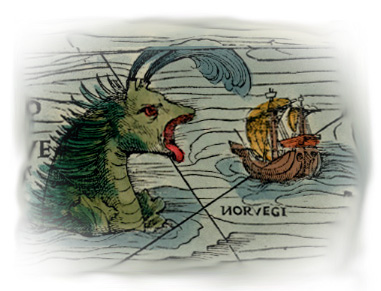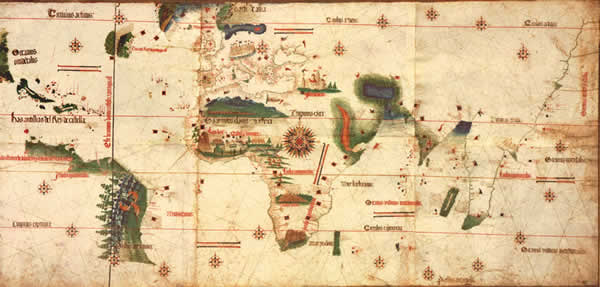Changing World Views

Seamonster from the Olaus Magnus Map of Scandinavia, 1539. Click
here to see the full map, including other seamonsters.
By the end of the Middle Ages, there existed among Europeans two views about the far reaches of the earth, which often intertwined depending on the education and outlook of the particular individual. The popular view was held by the general population, when they had the leisure-infrequent at best-to consider the wider world; the educated view was held by an elite segment of the population, those with a cathedral school or university education or those whose views were informed by conversation and instruction from the educated elite.
The Popular View: Sea monsters and One-Eyed Giants
The view held by most ordinary people, that is, those without an advanced education, was that the world beyond the edges of the three known continents-Europe, Asia, and Africa-was a frightening place, inhabited by strange and mysterious creatures. This popular view was informed by tales that sailors and other travelers told about the strange customs and inhabitants of far away lands, by folktales and songs that were performed at family and community gatherings, and by the demons and devils rampant throughout both Christian and Judaic sermons and teachings. It also was elaborated in the writings of medieval travelers such as Marco Polo (1254-ca. 1324) and some of the more romantic travel writers, such as Sir John Mandeville (ca. 1338-ca. 1400). Their work, like earlier classical literature, depicted sea monsters, one-eyed giants, dog-headed cannibals, and other monstrous beings at the edges of the known world. These stories spread across Europe, Asia, and North Africa via folktales and legends, giving shape to a fantastical popular world view for the largely illiterate common folk, who rarely traveled beyond their own towns or provinces.

The educated view: Ptolemy and the roots of Renaissance mapmaking
Scholars and many educated people held a more nuanced view of the known world, informed by the work of centuries of scholarship, as well as religious dogma. The Renaissance humanists of the late 14th century focused their attention on the classical world of ancient Greece and Rome, and the mapmakers of the day drew on classical geography, astrology, and mathematics for their knowledge of the known world. Thus, they knew the earth was a sphere, they understood the concepts of longitude and latitude (even if they were unable to calculate them accurately), and they, like their ancient forebears, speculated about a "fourth" part of the world, as yet unseen by modern men.
The scholar who most influenced Renaissance mapmaking was Claudius Ptolemaeus (ca. 90-168 C.E.), popularly known simply as Ptolemy. A Greek citizen who lived in Alexandria, Egypt, then part of the Roman Empire, Ptolemy established the ideas that would determine the principles of cartography well into the sixteenth century. Ptolemy applied geometric theory to explain the movement of the planets and the relative positions of the known continents (Europe, Asia, Africa). His was the first known projection of the world as a globe and he was the first to use longitude and latitude. His most influential work, Cosmographiae (also known as Geographiae), published in manuscript ca. 150 C.E., informed generations of mapmakers in both the Christian and Muslim worlds. When Renaissance mapmakers designed their maps, it was from Ptolemy's ideas that they drew; they based their maps upon Ptolemy's models, using Ptolemy's projections and promulgating his mistakes. For example, Ptolemy believed the circumference of the earth to be 180 degrees rather than 360 degrees-a distinction that would become significant in the creation of the two 1507 maps of Martin Waldseemüller.
Aided by the creation of the first European printing presses in the mid-15th century, these cartographers reproduced their Ptolemaic maps with ever-increasing frequency. As Portuguese explorers slowly explored the Atlantic coast of Africa, venturing ever southward until they rounded the Cape of Good Hope, the geographic information they obtained was integrated into new Ptolemaic maps. The effects of this integration were two-fold: the principles that Ptolemy established remained fundamental to cartography and navigation, yet specific cartographic knowledge was updated, lending both veracity and legitimacy to both new and ancient cartography.
Although the so-called educated view drew from geography and other scientific fields of study, like the popular view, it, too, was colored by religious belief and popular legend, reflections of which often found their way onto the maps of the day. Nevertheless, both perspectives of the world were cumulative, changing over time as knowledge was gained and opinions were revised.



